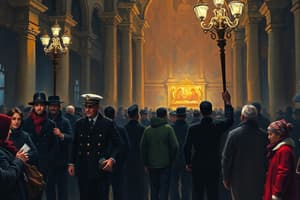Podcast
Questions and Answers
A casual crowd is characterized by minimal interaction among its members.
A casual crowd is characterized by minimal interaction among its members.
True (A)
An expressive crowd is focused primarily on achieving a shared goal or purpose.
An expressive crowd is focused primarily on achieving a shared goal or purpose.
False (B)
The quality of advance intelligence is crucial for effective crowd management.
The quality of advance intelligence is crucial for effective crowd management.
True (A)
Protest crowds are defined by their anger and are primarily chaotic in nature.
Protest crowds are defined by their anger and are primarily chaotic in nature.
Conventional crowds consist of people who come together without any planned agenda.
Conventional crowds consist of people who come together without any planned agenda.
An explosive crowd can develop from high tension, leading to potentially destructive behaviors.
An explosive crowd can develop from high tension, leading to potentially destructive behaviors.
Crowd management requires planning, organizing, and staffing.
Crowd management requires planning, organizing, and staffing.
The characteristics of the facility are irrelevant to effective crowd management.
The characteristics of the facility are irrelevant to effective crowd management.
Flashcards
What is a crowd?
What is a crowd?
A large group of people gathered in a specific location at the same time.
What is crowd management?
What is crowd management?
The process of managing large groups of people, considering factors like event type, location, crowd size, and communication.
What is a casual crowd?
What is a casual crowd?
A group of people gathered without a specific purpose or organization, with minimal interaction.
What is a conventional crowd?
What is a conventional crowd?
Signup and view all the flashcards
What is an expressive crowd?
What is an expressive crowd?
Signup and view all the flashcards
What is a protest crowd?
What is a protest crowd?
Signup and view all the flashcards
What is an acting/explosive crowd?
What is an acting/explosive crowd?
Signup and view all the flashcards
What are the types of crowds?
What are the types of crowds?
Signup and view all the flashcards
Study Notes
Crowd Definition
- A crowd is a relatively large number of people in close proximity to each other.
- It can also be described as localized collectivities.
- Alternatively, a crowd is a large number of people gathered together in the same place and at the same time.
Crowd Management
- Crowd management considers various factors of an event, such as the event type (e.g., circus, sporting event, theater, concert, rally, parade), facility characteristics, crowd size and behavior, entrance methods, communication strategies, crowd control, and queueing systems.
- Similar to other management practices, crowd management includes planning, organizing, staffing, directing, and evaluating.
- Crucial aspects of crowd management include defining the roles of involved parties, evaluating the quality of advance intelligence, and ensuring the effectiveness of the overall planning process.
Crowd Density
- Crowd density can be identified when there are 10 square meters available for every 40 people in a moving crowd, and 47 people in a standing area of 10 square meters.
Types of Crowds
- Casual Crowds: Large groups of people temporarily in the same location with minimal interaction; examples include commuters, farmers' market shoppers.
- Conventional/Cohesive Crowds: Groups gathered for a scheduled event; interaction is common due to shared interest and focus, such as concerts or graduations.
- Expressive Crowds: Groups gathering to release similar emotions; examples include funerals for mourning or celebrations after elections.
- Protest/Aggressive Crowds: Driven by shared purpose, such as advocating for change or expressing dissatisfaction.
- Acting/Explosive Crowds: Emerge from high tension or anger leading to chaotic, destructive behavior, like riots or stampedes.
Studying That Suits You
Use AI to generate personalized quizzes and flashcards to suit your learning preferences.




